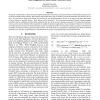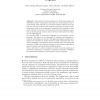25 search results - page 5 / 5 » Techniques for Recognizing Textual Entailment and Semantic E... |
LREC
2010
13 years 6 months ago
2010
We present a method and a software tool, the FrameNet Transformer, for deriving customized versions of the FrameNet database based on frame and frame element relations. The FrameN...
LOGCOM
2008
13 years 5 months ago
2008
Question Answering (QA) is a task that deserves more collaboration between Natural Language Processing (NLP) and Knowledge Representation (KR) communities, not only to introduce r...
EMNLP
2008
13 years 6 months ago
2008
Human linguistic annotation is crucial for many natural language processing tasks but can be expensive and time-consuming. We explore the use of Amazon's Mechanical Turk syst...
CALCO
2005
Springer
13 years 10 months ago
2005
Springer
Event-pattern reactive programs are front-end programs for distributed reactive components that preprocess an incoming stream of event stimuli. Their purpose is to recognize tempor...
SAMOS
2004
Springer
13 years 10 months ago
2004
Springer
The dataflow interchange format (DIF) is a textual language that is geared towards capturing the semantics of graphical design tools for DSP system design. A key objective of DIF i...


